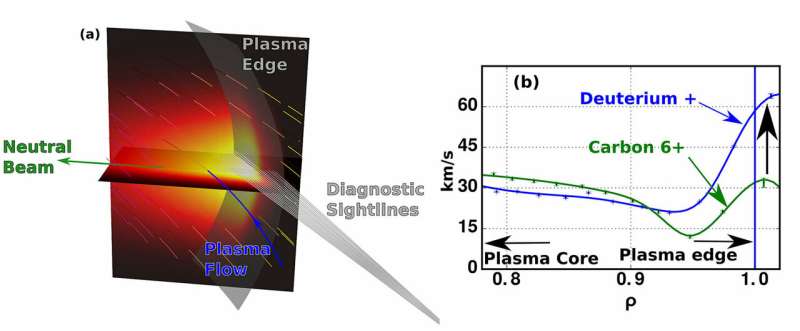Not all ions in tokamaks go with the flow

For the first time, scientists are measuring the rotation of the main (deuterium) plasma in the edge region of a fusion device. New spectroscopic measurements combined with state-of-the-art spectroscopic simulation made this measurement possible. The observed rotation at the plasma edge is substantially higher than previously thought based on measurements of impurity elements in the plasma.
The higher rotation is potentially good news for ITER and future reactors. Why? Plasma rotation is beneficial for fusion performance by improving both stability and confinement. Future research will use these measurements to develop improved theories of plasma flow in fusion reactors.
Scientists from the Princeton Plasma Physics Laboratory working on the DIII-D National Fusion Facility, in cooperation with scientists at General Atomics and the University of California at Irvine, are making new direct measurements of the bulk plasma (deuterium ion) flow near the boundary of hot fusion plasmas. The method is a breakthrough. Previously, scientists inferred the bulk of the plasma flowed based on the flow of impurities. However, the flow of impurities isn't a reliable guide near the edge of the plasma. The spectroscopic measurements of deuterium rotation reveal that the plasma flow velocity can be considerably higher than calculations based on the flow of carbon impurities in the plasma. The team obtained the new measurements after installing new optics to collect the light emitted by deuterium ions intercepting the neutral beams and performing computationally intensive 3-D simulations that allow for quantitative interpretation of the complex multi-component photoemission spectrum.
The direct measurement of the bulk plasma flow is providing researchers with unprecedented information on the mechanism of flow generation in fusion plasmas. Rotation is beneficial in fusion plasmas, and current experiments often generate rotation through the injection of neutral beams that spin up the plasma. However, a fusion reactor will have a relatively weak source of external momentum, so it is particularly important to understand the mechanism of observed self-generated flow and its implications in future reactors, such as ITER. The fact that the bulk plasma flow is higher than expected based on impurity measurements is potentially good news for ITER as less externally generated flow may be needed to achieve the same plasma flow.
More information: S R Haskey et al. Main ion and impurity edge profile evolution across the L- to H-mode transition on DIII-D, Plasma Physics and Controlled Fusion (2018). DOI: 10.1088/1361-6587/aad702
S. R. Haskey et al. Active spectroscopy measurements of the deuterium temperature, rotation, and density from the core to scrape off layer on the DIII-D tokamak (invited), Review of Scientific Instruments (2018). DOI: 10.1063/1.5038349
Arash Ashourvan et al. Validation of the kinetic-turbulent-neoclassical theory for edge intrinsic rotation in DIII-D, Physics of Plasmas (2018). DOI: 10.1063/1.5018326
Journal information: Review of Scientific Instruments , Physics of Plasmas
Provided by US Department of Energy



















